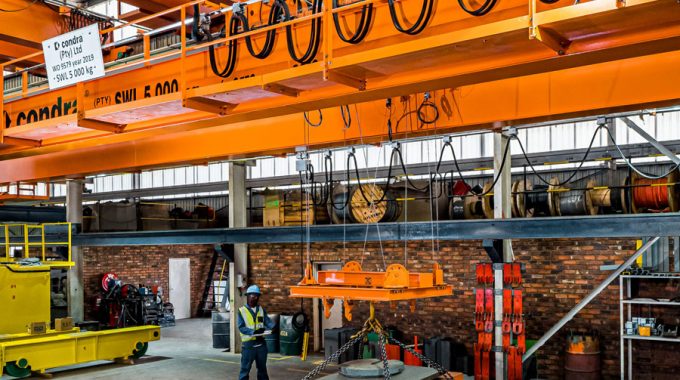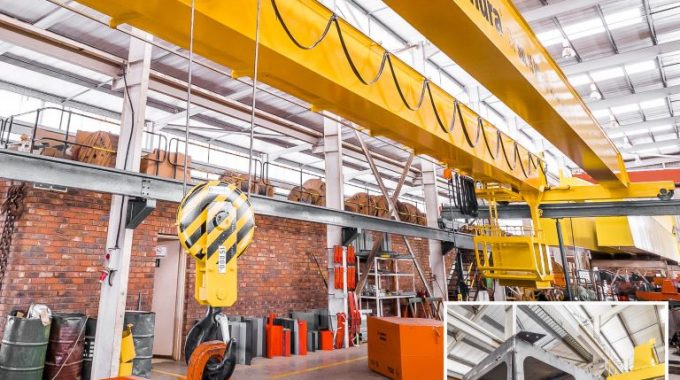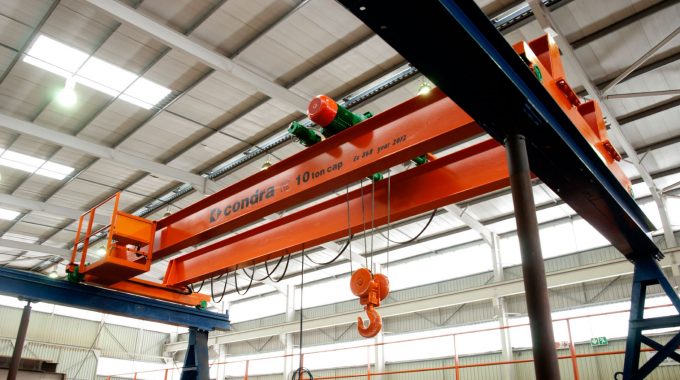VERY COMPACT CRANE DELIVERS HIGHER THAN NORMAL LIFTING HEIGHT
Condra has manufactured and delivered a 30/10-ton overhead crane designed to marry two mutually opposing tender specifications: high lift-height and tight overall dimension.
The double-girder electric overhead travelling crane is for dragline house maintenance. A 30 ton crab-mounted main hoist will service hydraulic cylinders, motors and gearboxes within the house while an auxiliary 10-ton underslung hoist executes additional duties, including external loading and unloading of equipment.
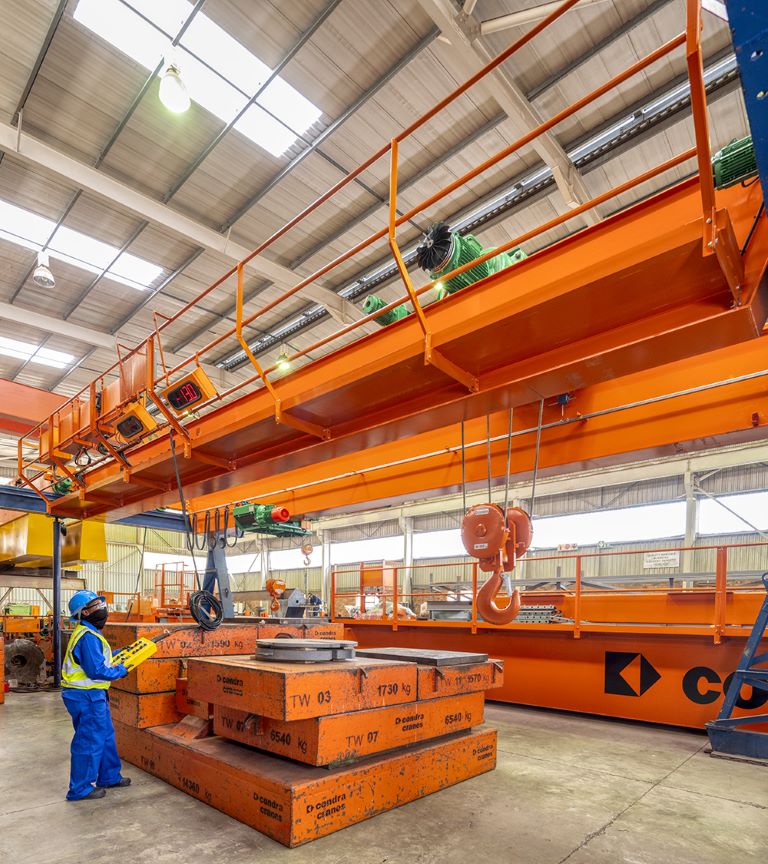
Condra delivered the machine on December 9. The order was received in August last year.
Crane design was made complex by two customer specifications: first, the need for the main hoist to deliver a higher than normal lifting height measured as a percentage of the available vertical dimension; second, the requirement for overall dimensions to be sufficiently compact to enable the working crane to move in and out of the existing crane aperture in the wall of the dragline house.
These two design requirements run contrary to one another in that a greater lift height is usually achieved by designing a physically bigger hoist working from a larger crane.
Condra’s machine will clear the aperture frame with just 50 millimetres to spare.
The specification was met by careful design of three distinct aspects. First, the main hoist was designed around a high-tensile rope with reduced diameter, allowing a smaller rope-drum and more compact hoist. Second, smaller wheels, suitably hardened, were used on the long and cross-travels of the crane, driven by more powerful motors. Third, girder webs were made smaller and combined with top and bottom flanges of thicker steel plate to maintain deflection criteria.
“In a nutshell, we met the customer specification by designing key crane elements to be smaller but stronger,” explained Condra managing director Marc Kleiner.
“All credit for a successful outcome must go to our design office, which worked hard to meet this demanding specification.”
Competition for the contract was stiff. Tenders representing most major crane brands were submitted. However, Condra proved better able than rival companies to meet the complex and conflicting design criteria.
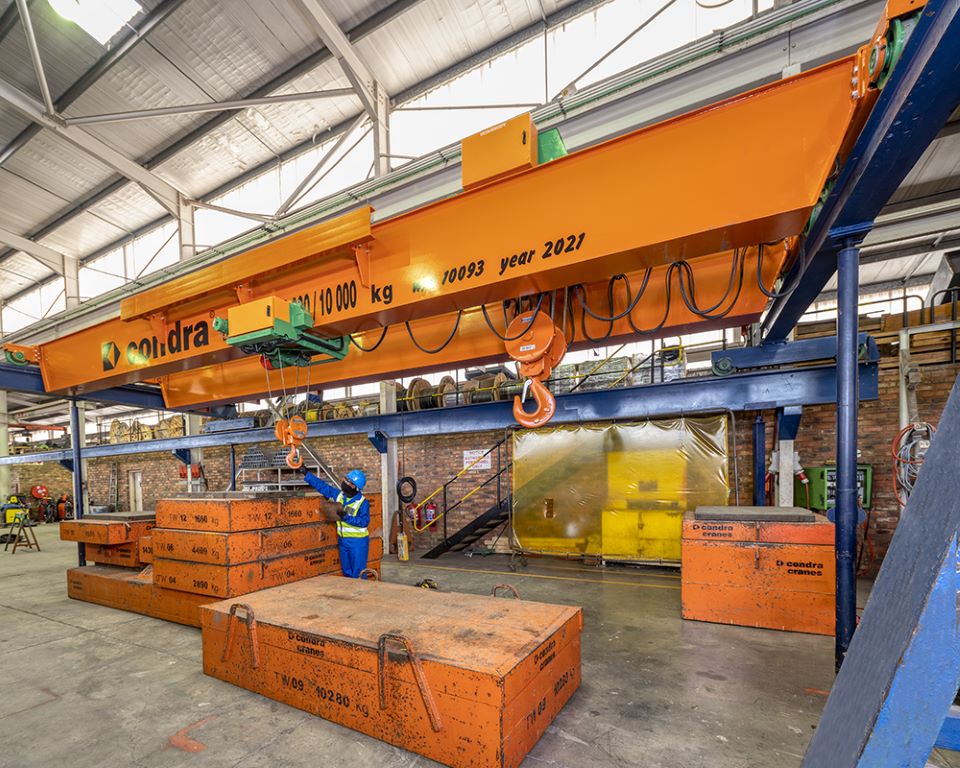
The newly delivered crane features digital load cell read-outs, remote control, lights, and a buffer to protect the underslung hoist against damage by other machinery working in the confined space of the dragline house. It joins a long list of lifting equipment manufactured by this Johannesburg-based company for mining applications over the past fifty-five years.
Condra has recently captured an increasing share of the sub-Saharan market for cranes and hoists, and success in securing orders against determined competition from other major market participants seems set to continue.
Management claims the highest local content of any overhead crane manufacturer in central and southern Africa.
The product range encompasses capacities from 250 kg to 500 tons with a fully automated option offered on all machines. Manufacture is to ISO 9000 standard.
The double-girder electric overhead travelling crane is for dragline house maintenance. A 30 ton crab-mounted main hoist will service hydraulic cylinders, motors and gearboxes within the house while an auxiliary 10-ton underslung hoist executes additional duties, including external loading and unloading of equipment.

The 30/10-ton maintenance crane being prepared for load test,
showing digital readouts (left of photo) and the underslung
auxiliary hoist in the background.
Condra delivered the machine on December 9. The order was received in August last year.
Crane design was made complex by two customer specifications: first, the need for the main hoist to deliver a higher than normal lifting height measured as a percentage of the available vertical dimension; second, the requirement for overall dimensions to be sufficiently compact to enable the working crane to move in and out of the existing crane aperture in the wall of the dragline house.
These two design requirements run contrary to one another in that a greater lift height is usually achieved by designing a physically bigger hoist working from a larger crane.
Condra’s machine will clear the aperture frame with just 50 millimetres to spare.
The specification was met by careful design of three distinct aspects. First, the main hoist was designed around a high-tensile rope with reduced diameter, allowing a smaller rope-drum and more compact hoist. Second, smaller wheels, suitably hardened, were used on the long and cross-travels of the crane, driven by more powerful motors. Third, girder webs were made smaller and combined with top and bottom flanges of thicker steel plate to maintain deflection criteria.
“In a nutshell, we met the customer specification by designing key crane elements to be smaller but stronger,” explained Condra managing director Marc Kleiner.
“All credit for a successful outcome must go to our design office, which worked hard to meet this demanding specification.”
Competition for the contract was stiff. Tenders representing most major crane brands were submitted. However, Condra proved better able than rival companies to meet the complex and conflicting design criteria.

The other side of the same crane, showing the underslung
auxiliary hoist with protective buffer above.
The newly delivered crane features digital load cell read-outs, remote control, lights, and a buffer to protect the underslung hoist against damage by other machinery working in the confined space of the dragline house. It joins a long list of lifting equipment manufactured by this Johannesburg-based company for mining applications over the past fifty-five years.
Condra has recently captured an increasing share of the sub-Saharan market for cranes and hoists, and success in securing orders against determined competition from other major market participants seems set to continue.
Management claims the highest local content of any overhead crane manufacturer in central and southern Africa.
The product range encompasses capacities from 250 kg to 500 tons with a fully automated option offered on all machines. Manufacture is to ISO 9000 standard.
